By
Samuel
L. Leiter
For comprehensive background on
Brooklyn’s pre-20th-century theatre history please see my
book, Brooklyn Takes the Stage: Nineteenth-Century Theater in
the City of Churches (McFarland: 2024) and my blog, “Annals of the Brooklyn Stage.” The
latter is a week by week description of theatre activity in Brooklyn;
obviously, it will expand rather slowly because so much must be described and
the present blog will be occupying my attention until live theatre in Brooklyn
begins to fade over the early decades of the 20th century,
dying out by the 1930s.
The entries in this blog began as
annual ones, for 1898 and 1899. Because of the large amount of memory used,
which made editing them problematic, subsequent entries were shortened so they
covered only several months at a time, but these too needed to be shortened.
Thus, beginning with 1901: September, all entries cover a single month.
The quickest way to find any of these entries is probably to click on the
following link, where links to everything prior to its date are provided: 1901: DECEMBER
Links to all of 1902’s posts can be
found here.
Links to all of
1903’s posts can be found here.
January 1904, theatrically speaking, was a rich month for Brooklyn.
Among the multiple offerings of its very first week there were three first-class
hits and stars competing for local dollars. One was the recent comic opera Red
Feather, starring Grace Van Studdiford, another was Cousin Kate,
starring Ethel Barrymore, and the third was The Darling of the Gods,
starring Blanche Bates; we shall have more to say about this show in particular.
As the listings below reveal, there were plenty of other interesting
things available, most notably a melodrama called For His Brother’s Crime
starring a good-looking actor so spectacularly muscular that one critic thought
he was blazing a path for a new type of dramatic hero. His name was Montgomery
Irving and there is precious little information available about him, although
he seems to have made a name for himself more as a vaudeville strongman than an
actor (I’m not aware of any other plays that cast him). The only two photos I
could find are those in the newspaper clippings below, not even mentioned during
conventional online searches.
Dubbed “the modern Hercules of the American stage,” he played twins,
one evil and one good, and engaged in an exciting combat carried out in a gym,
where one of his characters was a blacksmith passing himself off as a physical
culture instructor. During the fight, when attacked by ten men and a rival strongman,
the “Moorish Giant,” he did battle with a pair of huge broadswords. Among other
feats of enormous strength, he “actually supports the weight of a huge wooden
bridge while a carriage containing four people and drawn by two horses dashes
over it.” A standing offer was made of $1,000 to anyone who could duplicate
this feat.
Other stage highlights of the month included Brooklyn’s own Grace
George in Pretty Peggy; Richard Buhler as Paul Revere, in which
he made his famous midnight ride on a horse running on a treadmill; comic Frank
Daniels in The Office Boy; séance-fraud buster Prof. Samri Baldwin, “The
White Mahatma,” occupying Corse Payton’s Fulton Street Theatre for three weeks
(a sign that Fulton Stock Company was in trouble); a week of grand opera at the
Amphion; wannabe star Thomas E. Shea with a three-play in the Henry Irving vein;
and everybody’s stage sweetheart, Maude Adams, in The Pretty Sister of Jose,
cast in the unlikely role of a spirited Spanish village girl.
Entertaining as these shows may have been (or not), a damper was placed
on Brooklyn theatricals because of the attention brought to theatre safety by
the recent catastrophe at Chicago’s Iroquois Theatre, which had made
theatregoers uneasy around the world. On January 9 it was reported that Martin
W. Littleton, borough president, had closed the gallery and balcony sections of
six Brooklyn theatres—the Amphion, Novelty, Payton’s Lee Avenue, Unique, Star,
and Park—to inspect them for safety violations that could foster a disaster in
case of fire. The papers were filled with details of what was involved, which
we needn’t repeat here, but numerous dangers were uncovered and had to be
remedied before those seats could again be filled. The young boys who often flocked
to the cheaper venues on this list were deeply aggrieved. A number of other
theatres were found to have flaws that had to be corrected, but were not placed
under any restraints for the moment. Naturally, similar inspections and restrictions were
occurring in Manhattan and elsewhere in the Greater New York City area.
Of all the shows visiting Brooklyn in January 1903 the one that
most beguiles me (those who know my background will understand) is David
Belasco’s universally admired The Darling of the Gods, a Japanese tale
written by him and John Luther Long, with whom he also wrote Madame
Butterfly (1900; the source of Puccini’s opera). The Darling of the Gods
mingles historical fact with dramatic fiction and wouldn’t withstand close
scrutiny by a Japanologist, but the spectacle of its costumes, makeups,
scenery, and the high-quality of its acting and production, with a cast of over
100 (quite common for large-scale shows back then), helped it run for 344
performances in Manhattan. At just about the same time, a duplicate London
production starring Herbert Beerbohm Tree was opening.
But because of the war between Belasco and Klaw and Erlanger of the
Theatrical Syndicate, he had to avoid their Brooklyn venues. (Interested readers
should check Hamilton Ormsbee's explanation of the war’s inception and the decision
to rent the Lee Avenue in the Eagle, January 3, 1904). Klaw and
Erlanger had struck back at Belasco’s intransigence by mounting A Japanese
Nightingale, but, forced to close it soon after, they sent it on the road,
where it was currently hoping to weaken demand for Belasco’s play when it also
began to tour.
The recent loss to fire of the Brooklyn Academy of Music had
eliminated a principal outlet. And, because so much Academy time was occupied for
split week engagements, it was difficult to book it for a full week. Belasco
had therefore contracted with Corse Payton to rent his Lee Avenue Theatre for a
week. The local press was fascinated by the arrangement of an elite production
opening at a popular-price stock company playhouse and hoped it would provide away
for other independents to play at non-syndicate Brooklyn houses, breaking the
syndicate’s stranglehold on what local theatres could and could not present. But
it was Belasco himself whose commitment to Brooklyn was most devoutly to be
wished for because of the power associated with his productions and the stars
he managed.
For those unfamiliar with this colorful old play, written in ten
scenes, here’s a brief introduction from Brooklyn Life (January 2,
1904).
It is a most absorbing melodrama of the life of old
Japan about a generation ago [1876]—in the days when the Samurai were deprived
of their swords by the Emperor. The relentless pursuit of the little band of
two-sword men, who refuse to obey the sword edict by the crafty war minister,
Zakkuri [George Arliss], and their final extermination, is a tragic tale of
horror after horror; but what with the undying love of Yo-San [Blanche Bates],
the beautiful daughter of Saigon [Charles Walcot], Prince of Tosan, for Prince Kara
[Robert T. Haines]—the leader of the outlaws—a love enduring beyond all earthly
relations—and the superb appeal to the eye, the unpleasant features resolve
themselves into merely the shadows of a gloriously fine panoramic picture.
1.
January 4-9, 1904
Amphion: Red Feather, with Grace Van Studdiford
Bijou: (Spooner Stock Company) Will She Divorce Him?
Columbia: For His Brother’s Crime, with Montgomery Irving
Folly: Drink, with Charles Warner
Gotham: The Stain of Guilt
Grand Opera House: Dr. Jekyll and Mr. Hyde, “The
Bells,” Richelieu, with Thomas E. Shea
Montauk: Cousin Kate, with Ethel Barrymore
Novelty: Nobody’s Claim
Park: Trinity Chimes
Payton’s Fulton Street: (Payton Fulton Street Stock Company)
Drifted Apart
Payton’s Lee Avenue: (Payton Lee Avenue Stock Company) The
Darling of the Gods, with Blanche Bates, George Arliss
Phillips’ Lyceum: (Lyceum Stock Company) The Dangers of
Paris
Vaudeville and burlesque: Hyde & Behman’s, Star, Gayety,
Unique, Watson’s, Orpheum
2.
January 11-16, 1904
Amphion: Pretty Peggy, with Grace George
Bijou: (Spooner Stock Company) Strangers in a Strange
Land
Columbia: Paul Revere, with Richard Buhler
Folly: A Desperate Chance
Gotham: Too Proud to Beg
Grand Opera House: The Queen of the White Slaves
Montauk: The Office Boy, with Frank Daniels
Novelty: For His Brother’s Crime, with Montgomery
Irving
Payton’s Fulton Street: (Payton Fulton Street Stock Company)
The Young Wife, with Corse Payton, Etta Reed Payton
Park: Rachel Goldstein
Payton’s Lee Avenue: Prof. Samri Baldwin, “The White
Mahatma”
Phillips’ Lyceum: (Lyceum Stock Company) Lost in New York
Vaudeville and burlesque: Hyde & Behman’s, Star, Gayety,
Unique, Watson’s, Orpheum
3.
January 18-23, 1904
Amphion: Carmen, Lohengrin, Il Trovatore,
Tannhauser, Otello, The Bohemian Girl, with Henry W. Savage
English Grand Opera Company
Bijou: (Spooner Stock Company) Lady Betty’s Courtship
Columbia: Zaza, with Eugenie Blair
Folly: Dr. Jekyll
and Mr. Hyde, “The Bells,” Richelieu, Banished by the King,
with Thomas E. Shea
Gotham: Through Fire and Water
Grand Opera House: Arrah-na-Pogue
Montauk: The Pretty Sister of Jose, with Maude Adams
Novelty: Her First False Step
Park: A Working Girl’s Wrongs
Payton’s Fulton Street: Prof. Samri Baldwin, “The White Mahatma”
Payton’s Lee Avenue: (Payton Lee Avenue Stock Company) Denise,
with Etta Reed Payton
Phillips’ Lyceum: (Lyceum Stock Company) A Heart of Stone
Vaudeville and burlesque: Hyde & Behman’s, Star, Gayety,
Unique, Watson’s, Orpheum
4.
January 25-30, 1904
Amphion: The Triumph of an Empress, with Mildred Holland
Bijou: (Spooner Stock Company) Camille
Columbia: McFadden’s Flats
Folly: The Worst Woman in London
Gotham: Driven from Home, with Patrice
Grand Opera House: Soldiers of Fortune
Montauk: The Man from Blankley’s, with Charles Hawtrey
Novelty: The Stain of Guilt
Park: The Game Keeper
Payton’s Fulton Street: (Payton Fulton Street Stock Company)
Prof. Sami Baldwin, “The White Mahatma”
Payton’s Lee Avenue: (Payton Lee Avenue Stock Company) My
Friend from India, with Corse Payton
Phillips’ Lyceum: (Lyceum Stock Company) Old Sleuth
Vaudeville and burlesque: Hyde & Behman’s, Star, Gayety,
Unique, Watson’s, Orpheum
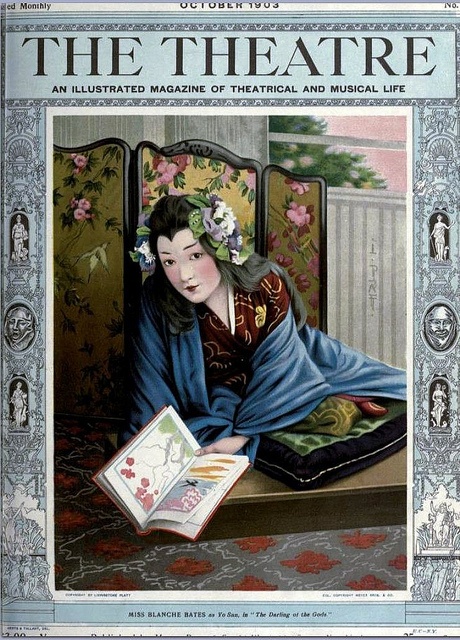

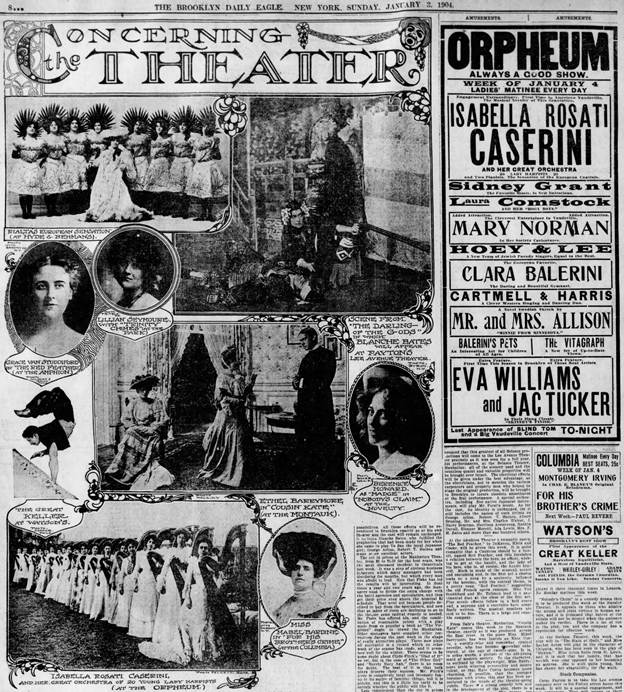
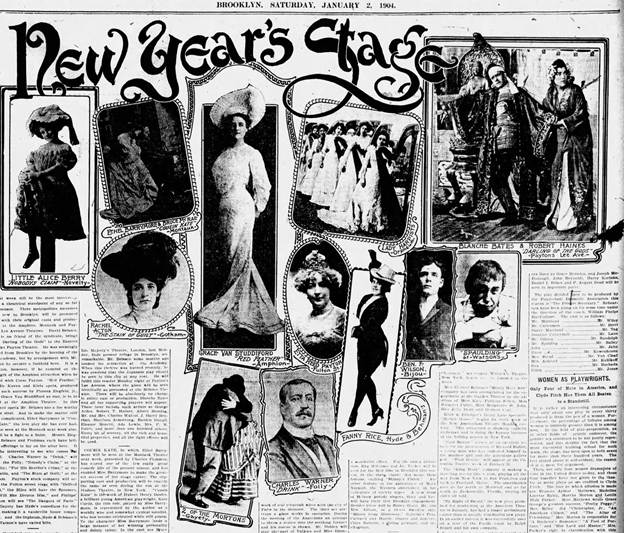



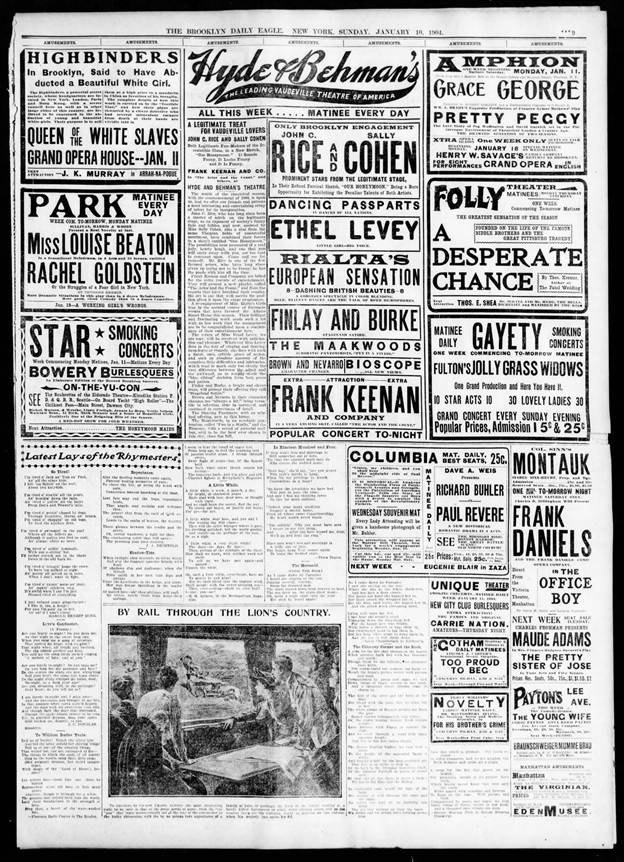


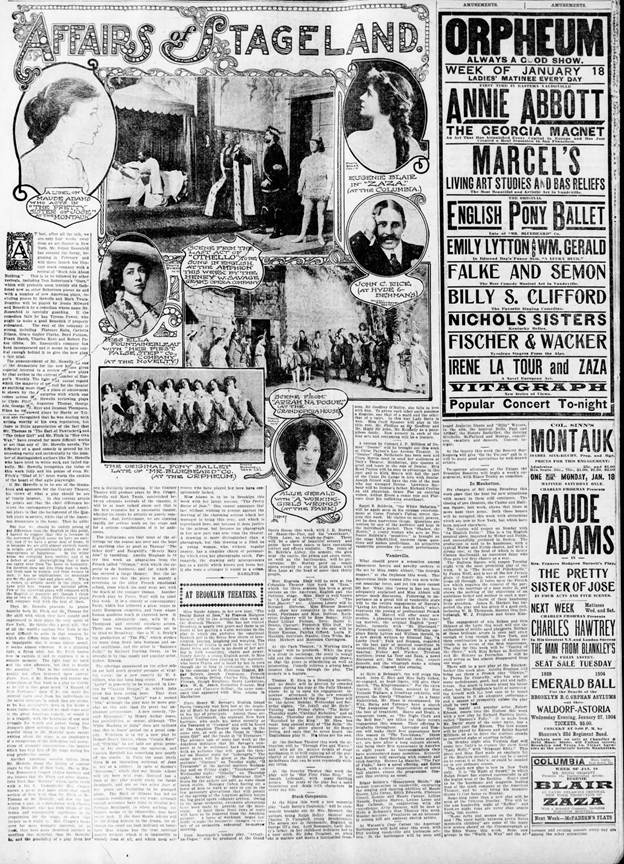










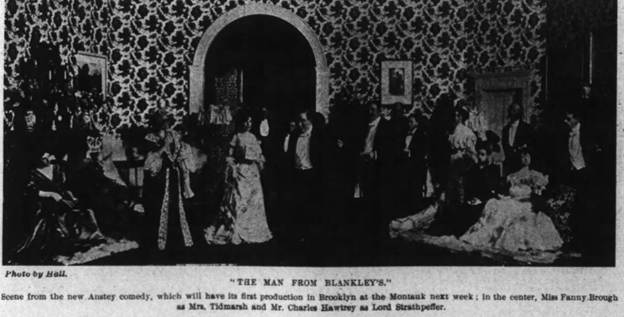




No comments:
Post a Comment